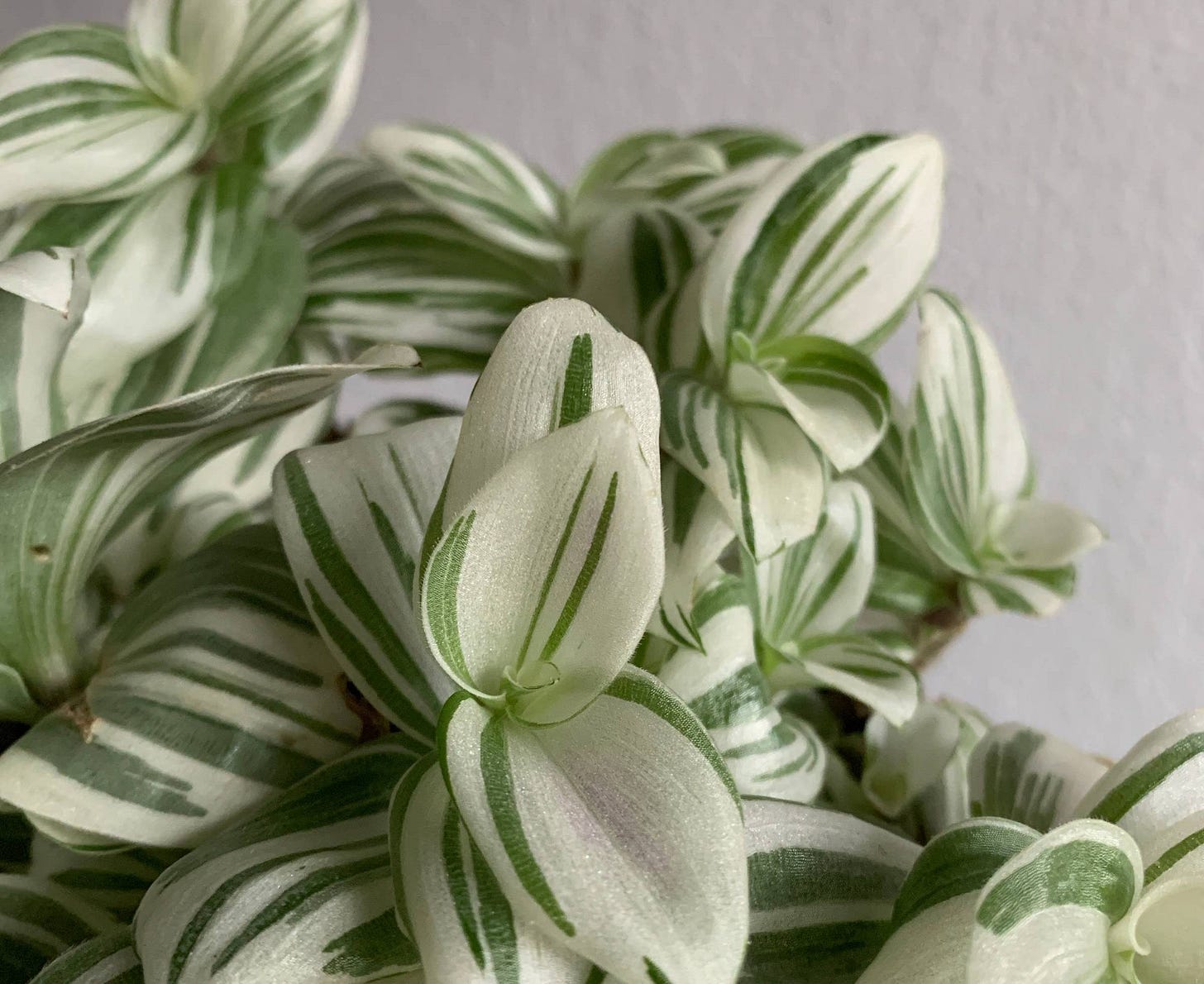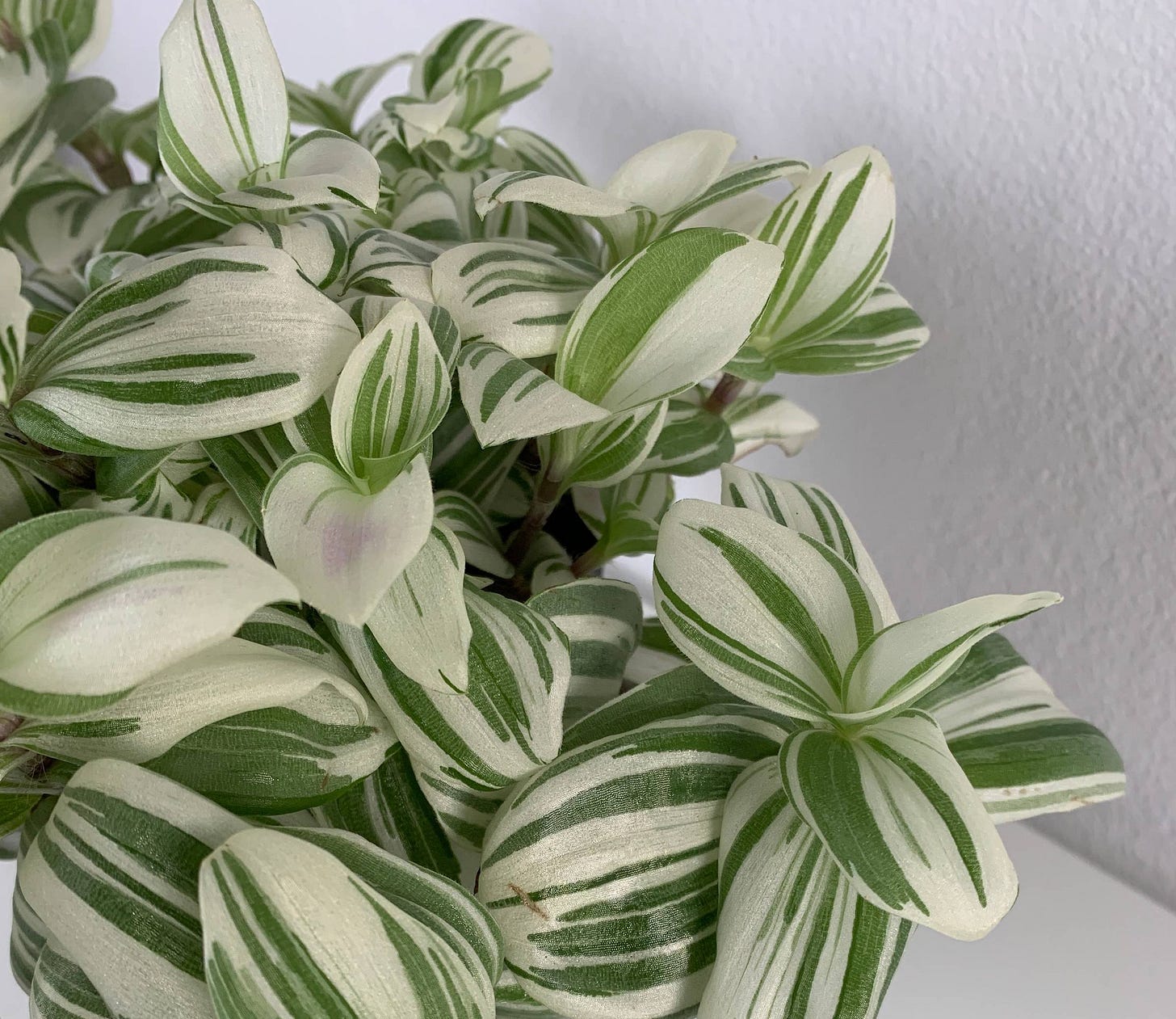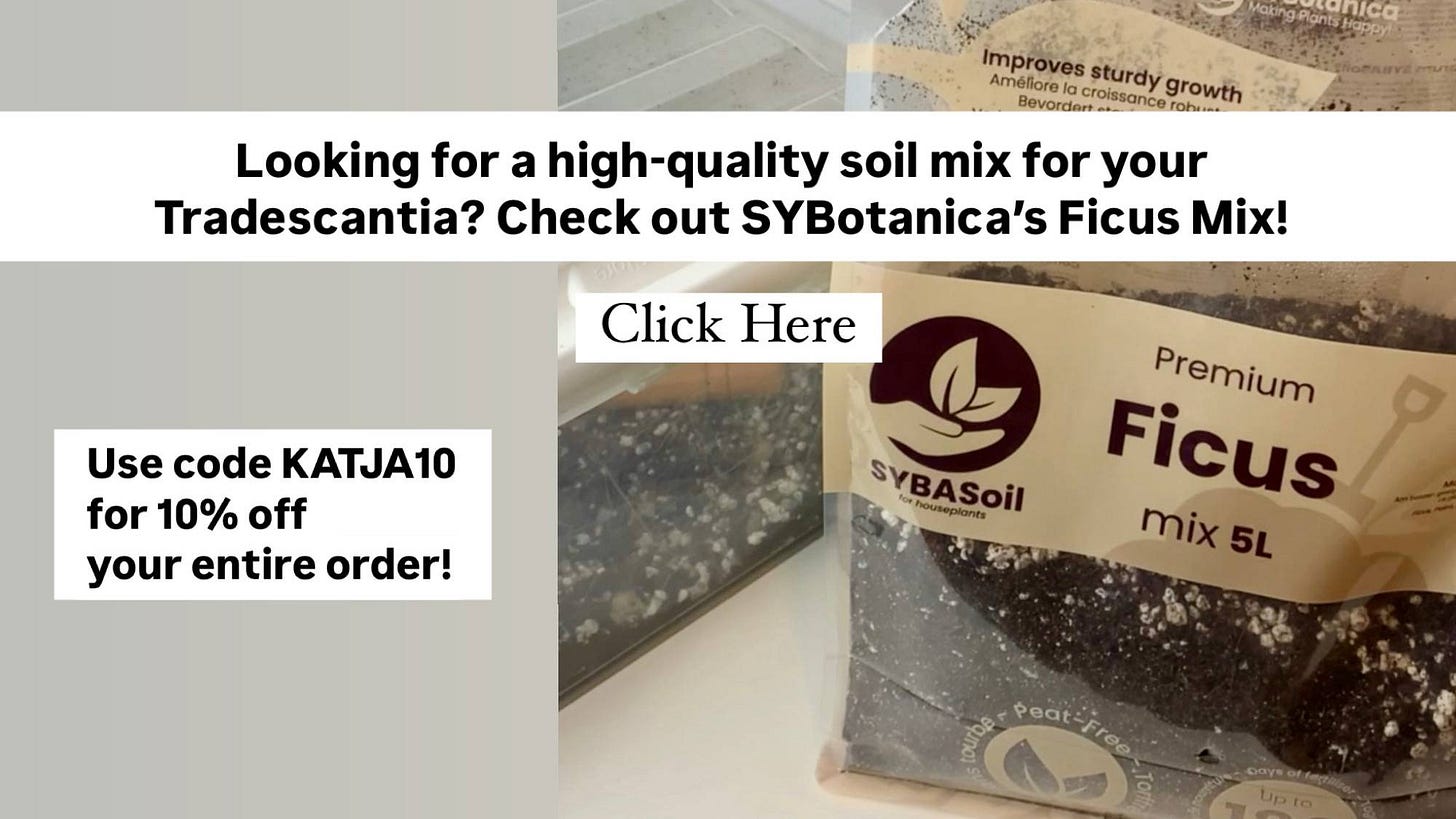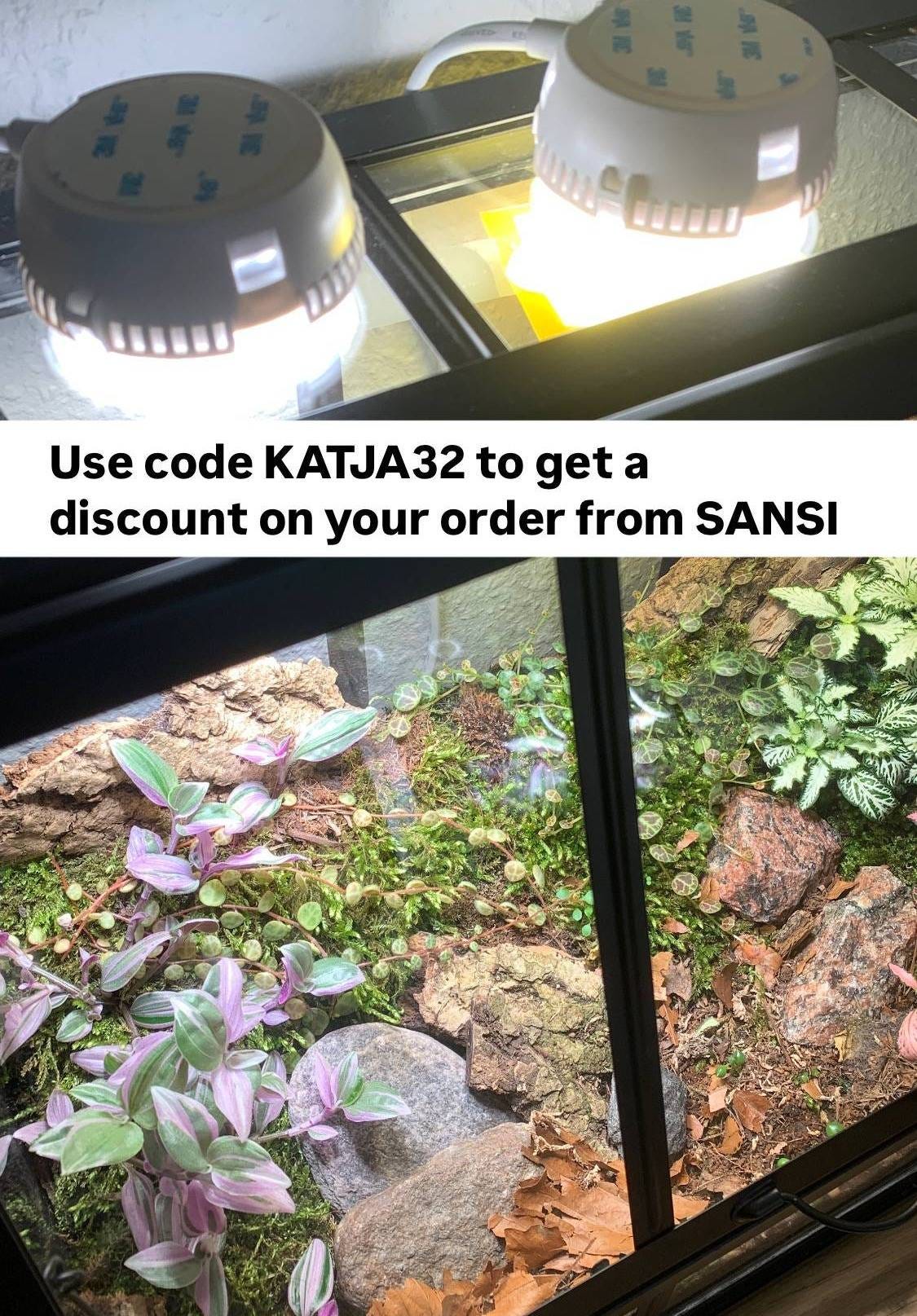Five Tradescantia Care Tips You Should Stop Following
When it comes to Tradescantias, there’s plenty of advice out there, but not all of it is good. In fact, some of the most common tips can do more harm than good.
Have you heard that you should water when the top inch of soil is dry? That you must never get the leaves wet? Or that Tradescantias can’t handle direct sun? Maybe even that fertilizer isn’t necessary, or that you can identify them just by looking at a picture chart?
These pieces of advice are repeated so often that they sound true, but following them can leave your plant weak, leggy, or even on the way to root rot. In this issue, I’ll break down why these “tips” don’t hold up, and what you should do instead to keep your Tradescantias healthy and happy.
Tradescantia of the week: EC-TRAD-2303 (Brightness)
Today I want to highlight Tradescantia EC-TRAD-2303 though you might know it better by the name Brightness! This cultivar was patented just last year and now officially goes by the name EC-TRAD-2303. It has only been around for a few years but has already become quite popular.
It was first discovered in the Netherlands as a mutated branch from what was said to be a Tradescantia Cerinthoides. But that’s a bit uncertain, since EC-TRAD-2303 doesn’t really share the same look or traits as Cerinthoides. Instead, it has been placed in the Continental Group, a collection of cultivars that are mostly believed to be hybrids. Many of them look very similar, which can make them tricky to tell apart. One example is White Giant, another white-variegated Tradescantia in the Continental Group, which is thought to look almost identical to EC-TRAD-2303.
EC-TRAD-2303 has quickly become popular, and it’s easy to see why. The white variegation is striking, and with enough light you may even notice soft hints of pink in the leaves. It’s also said to flower frequently, even when grown indoors… although mine hasn’t bloomed yet. I’m still waiting!
Five Tradescantia Tips You Should Ignore
When it comes to Tradescantias, there’s no shortage of plant care advice out there. The problem is, not all of it is good advice and some of it can actually do more harm than good. Here are five common tips you’ve probably heard, and why you should think twice before following them.
1. Water when the top inch of soil is dry
This advice often leads to overwatering. Since Tradescantias can store water in their stems and leaves, they’re actually quite good at handling drying out. Watering too often creates real problems for the roots.
When soil stays constantly wet, the air pockets in it get filled with water and the roots can’t absorb the oxygen they need to function. The longer this goes on, the more damage it causes. The roots quite literally suffocate. Without oxygen, they begin to rot, and once root rot sets in, the plant can no longer take up water and nutrients effectively. That’s when you start seeing yellowing leaves, slowed growth, and eventually parts of the plant dying back.
It’s much better to let Tradescantias dry out completely before watering again. Their roots will stay stronger, healthier, and more resilient. I often use a moisture meter to check if the soil has fully dried out. It’s not 100% exact, but it gives a good enough indication of whether the soil is still damp or ready for watering.
2. Never get the leaves wet
In reality, Tradescantias don’t mind water on their leaves at all. Outdoors they get rained on regularly and they’re just fine, so water on the leaves is not automatically a problem.
Still, this is one of those “go-to” explanations people often give whenever a Tradescantia shows brown spots, yellowing, or any other issue. It’s easy to blame water on the leaves, but in my experience, that’s rarely the real cause. More often, it comes down to things like inconsistent watering, poor soil drainage, pests, or simply not enough light.
I’ve never seen water on the leaves alone cause brown marks or damage. In fact, I did an experiment with my Nanouk where I sprayed the leaves every day for ten days just to test this. The result? No spots, no damage, just a healthy plant.
(You can even watch the video here!)
3. Don’t put your Tradescantia in direct sunlight
This one keeps coming up, but it’s very misleading and it often leads people to place their Tradescantias in far too little light. While it’s true that strong, sudden sun can burn the leaves, most Tradescantias actually do much better with a few hours of direct sunlight every day.
When they don’t get enough light, the results are easy to spot: they lose their colour, get leggy, and look weak. Instead of avoiding sunlight altogether, the key is to let your plant adjust gradually. If it has been in a darker corner, move it step by step into a brighter spot, and over time it will adapt.
Once used to stronger light, Tradescantias reward you with their best traits, vibrant colours, stronger stems, and compact, bushy growth.
4. Fertilizer isn’t necessary
It’s true that Tradescantias can survive for quite a while without fertilizer, but that doesn’t mean they don’t need food.
Regular fertilizing, especially during summer, makes a huge difference. Without it, growth slows down, new leaves come in much smaller, and you might even see yellowing or wrinkled leaves as the plant struggles to support itself.
The good news is, they don’t need much to stay happy. A balanced houseplant fertilizer, diluted to half strength and given about once every 4 weeks, is usually enough.
5. You can identify a Tradescantia just by looking at a picture chart
Many Tradescantias look almost identical at first glance, and their appearance can change a lot depending on light, water, and care. Charts are fun to look at, but they often oversimplify things. Proper identification usually requires knowing what to look for when it comes to details like leaf shape, type of variegation, colours, or even flowers, and even then, it can be tricky!
If you’d like to read more on how to identify Tradescantias, I’ve written an article that goes into more detail. You can read it here.
Until next time, happy planting! 🌿
Katja
Disclaimer: These are affiliate links, which means I earn a small commission if you make a purchase using my codes, at no extra cost to you. Your support helps me keep sharing Tradescantia tips and content—thank you!






